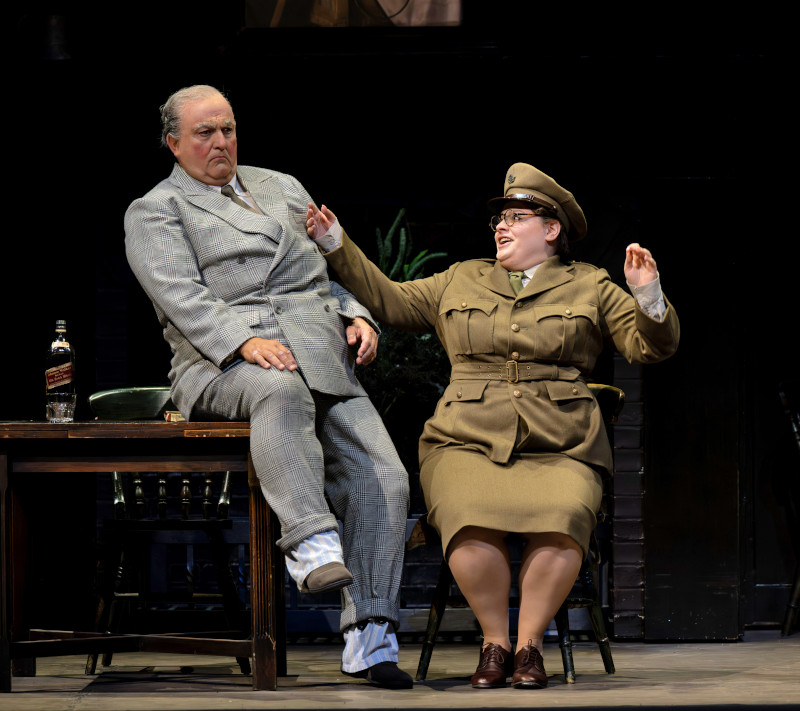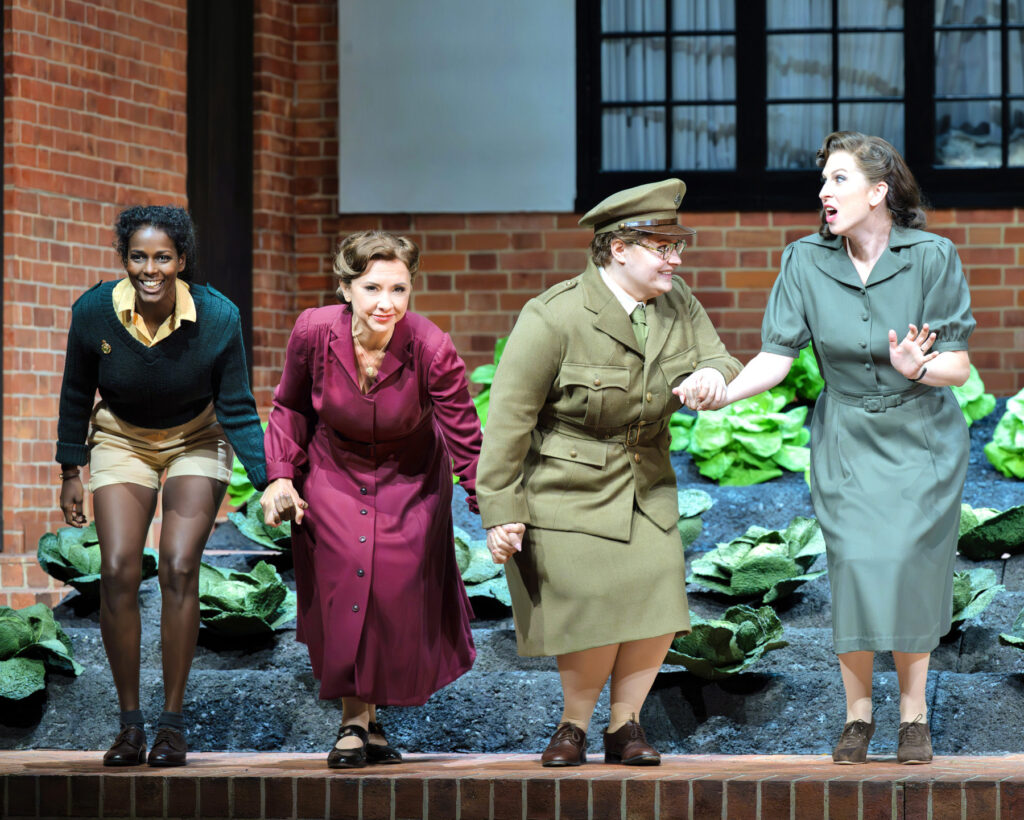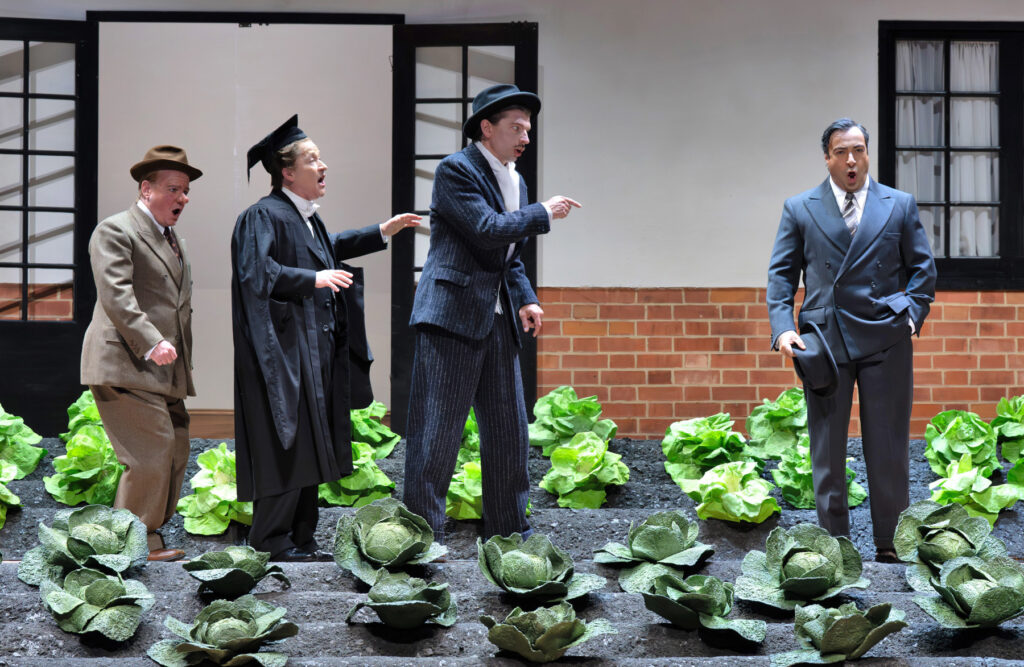In Richard Jones’s production of Verdi’s last opera, first seen in 2009, big, bold sets evoke mid-1940s Windsor, just after the end of the War. The mock Tudor facades of the buildings stand true to the form of early 20th century domestic architecture of the Home Counties, their aesthetic dishonesty echoing the deceptions at play within the comedy itself, as well as reprising the Tudor period of Shakespeare’s play (to all intents and purposes set within the playwright’s own time, rather than the purported time of Henry IV’s reign at the beginning of the 15th century). It’s a vision of Metroland with its suburban proprieties that you almost expect to hear John Betjeman to start rhapsodising about; or which, on the other hand, Falstaff might denounce with the disdain of Jonathan Meades, for its stultifying primness.
The larger-than-life sets have the same cartoonish vividness, and whiff of nostalgia, as the posters of British locations commissioned by railway companies in the mid-20th century. But their scale necessitates long, clunky changes between each scene, which rather holds up the drama’s energy – I can’t recall ever having seen so many, for so long, in an opera production. That is partly made up for by some visual motifs which connect the various scenes – three girls appear intermittently, either skipping joyously, or working on the curtain design like a tapestry of Windsor Castle seen from the Thames, and pre-empt the imps who swirl around as fairies in the concluding forest scene and beat Falstaff; and the river that is the site of Falstaff’s humiliation is alluded to with the occasional straying into the set of a group of rowers.

More overt, slapstick comedy is certainly there too, with Falstaff’s pretensions to romance with both Alice Ford and Meg Page sent up when they receive his identical letters in the decidedly unromantic setting of a cabbage patch. By setting the opera specifically in 1946, Falstaff’s own bawdy, decadent activities parody and challenge the new era of economic and moral austerity which arose immediately after the War that had unruffled so many certainties and established ways of life – Falstaff serving as a sort of ironic inversion of the message of the exactly contemporary film Brief Encounter which also promoted a return to social and marital normality. The fact that the concluding fugal chorus is addressed from the stage directly to the audience suggests that it’s Falstaff’s attitude of playful unconventionality and freedom from constraint which is the message to be drawn, not the po-faced earnestness of the other characters. At a cuter, smaller dimension, the Garter Inn’s feline pet reappears in the oak tree of the final scene, mischievously haunting the action like a Cheshire cat with its enigmatically knowing smile.

Renato Girolami gives an idiomatic account of the title role – as a native Italian he has a natural command of the word-setting that brings out Falstaff’s charisma in his singing alone, without resort to exaggerated gestures on stage. Rodion Pogossov efficiently conveys the anxiety of the nearly cuckolded Ford, also avoiding excess or caricature, while Anna Princeva as Alice rises above those suspicions and Falstaff’s antics with steady determination and clear focus in her performance. Mariam Battistelli gives an efflorescent performance as Nanetta complemented by her Fenton, as an American GI, in Filipe Manu’s account which is also ardent if somewhat constricted in tone. But musically they make a true romantic pair in this opera where all the other characters are set vocally much more directly and syllabically.

Valentina Pernozzoli successfully sustains a deadpan, frumpish Mistress Quickly in service uniform, which makes it all the wittier when she surprises Falstaff with her own subtly erotic gestures delivered to him in jest. The risqué, sexual frissons of the comedy are also satirised in having the disguised Bardolph, with his long nose, made up seemingly to resemble Quinten Massys’s picture The Ugly Duchess for the mock marriage with Dr Caius in the dark forest, both characters taken in light-hearted humour by Colin Judson and Gregory Bonfatti respectively. Callum Thorpe’s Pistol and Stephanie Lauricella’s Meg Page complete this cohesive cast.
Sian Edwards leads a deliberate account of a score that perhaps requires most of the orchestra of any opera by Verdi. It plods somewhat weightily into life, like the knight himself, and retains a certain rhythmic sturdiness rather than always capturing the music’s sparkling, spontaneous comedy. But the London Philharmonic are attentive to individual instrumental timbres that pick out an array of descriptive, picaresque detail, and does characterise the score’s sense of a witty banter.
Curtis Rogers
Falstaff
Composer: Giuseppe Verdi
Libretto: Arrigo Boito after Shakespeare’s The Merry Wives of Windsor
Cast and production staff:
Sir John Falstaff – Renato Girolami; Ford – Rodion Pogossov; Alice Ford – Anna Princeva; Nannetta – Mariam Battistelli; Fenton – Filipe Manu; Meg Page – Stephanie Lauricella; Mistress Quickly – Valentina Pernozzoli; Dr Caius – Gregory Bonfatti; Bardolfo – Colin Judon; Pistola – Callum, Thorpe
Director – Richard Jones; Designer – Ultz; Movement Director – Linda Dobell; Revival Movement Director – Lucy Burge; Lighting Designer – Mimi Jordan Sherin; Conductor – Sian Edwards; The Glyndebourne Chorus and London Philharmonic Orchestra
Glyndebourne Festival Opera, Lewes, East Sussex, England, Saturday 26 July 2025
Top image: Alice Ford (Anna Princeva), Mistress Quickly (Valentina Pernozzoli), Meg Page (Stephanie Lauricella), Dr Caius (Gregory Bonfatti), Ford (Rodion Pogossov), Bardolfo (Colin Judson), Pistola (Callum Thorpe) and members of the Glyndebourne Chorus.
All photos © Glyndebourne Productions Ltd. Photo: Bill Knight